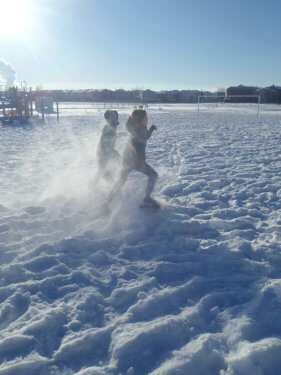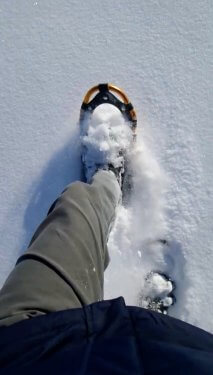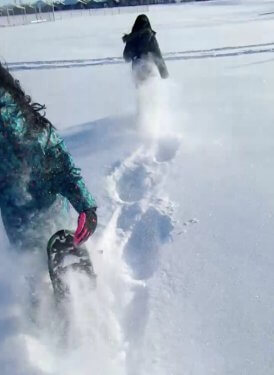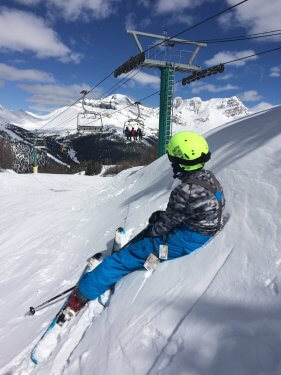It’s too cold outside! It’s snowing outside! There’s too much snow!
Have you heard these statements before in or near your schoolyard? If so, you’re not alone! The temperature seems to be a growing concern among children and youth. For some, the outside during winter months is “off limits!” Well, we disagree. We strongly believe that it is essential for children and youth to become regular physical activity participants outside. And right now, during the winter months, is the perfect time to help our students understand the possibilities and benefits of outside physical activity. So, as we journey through the last bit of winter, let’s get at it!

Before we share ideas of how to support students becoming active outside, we’d first like to point to some of the benefits of engaging in outside physical activity in colder temperatures. Benefits, which are further explained in a following section, include exposure to Vitamin D, fresh air, and the use of different muscle groups. Additionally, being active outside and engaging in a variety of movement experiences gives students opportunities to problem-solve and develop socially, as well as discover the fun of outdoor physical activity even in the cold.
Providing students with opportunities to explore their outside environment during the winter months can be easily done through including “outdoor winter activities” as a regular part of physical education lessons. However, this alternative learning environment does require different planning, instructional, and equipment considerations than those typically required for a lesson in a gymnasium setting. With that in mind, what are some important considerations?
C O L D E R – Elements
When teaching outside, teachers need to use all strategies at their disposal to support student learning. But it’s also important to introduce students to new experiences that can potentially enhance learning and support your students’ physical literacy journeys. To do this, we suggest considering C O L D E R Elements when providing students with quality winter outdoor activity opportunities.
Community
When planning outdoor winter activities, start by looking at the outdoor landscape around your school community.
School Property: Many schools have large fields that lend themselves well to countless game-type activities (e.g., snow tag, disk sports), team-building challenges (e.g., snow fort building, trail making), or winter-themed nature exploration (e.g., snowshoeing, cross-country skiing).
Planning Considerations
- Do the school grounds have any obstacles (e.g. playground equipment, picnic tables, planters) or natural landscapes (e.g. trees, rocks) that could be used for orienteering-type activities?
- Are there large open fields beyond the school property that could be used for target-type activities?
- Do the school grounds include small hills suitable for sliding-type activities?
- Is there a wooded area ideal for a winter-themed nature walk? (e.g. snowshoeing, cross-country skiing).
Teaching Tips
- Look for available community outdoor facilities. Perhaps there is an outdoor ice-covered area or hockey rink that can be accessed for activities such as skating, hockey, ringette, or broom ball.
- Check for a “curling” facility or another inside facility that your students could visit before going outside. Such an “indoor” activity can expose students to the benefits of participating in the activity and then be brought back to the school grounds in the form of “milk jug curling” on an ice-covered area of asphalt or the playground.

Outside Core
Teachers often face their own challenges when it comes to accessing physical education gymnasium space in winter. Lack of gymnasium space or multiple classes needing to share a gymnasium seems more common today because of schools operating at student capacity and school-wide events. Whatever the reasons, the letter “O” helps to remind us of the benefits of getting outside. While Table 1 is not an exhaustive list, it illustrates many of the benefits when students participate in outside physical activities.
| Table 1. Benefits of Outside Physical Activity | |
| Vitamin D | When students are outside, they are not only exposed to the potential of outside play, but also the necessary vitamins that the outdoor environment provides (e.g., Vitamin D through sun exposure) |
| Fresh Air | Nothing beats being outside on a nice crisp day; getting fresh air can promote calmness and happiness |
| Using Different Muscle Groups | Have you ever tried having a relay race in the playground on snow? If so, you will notice your running style is much different from running on regular grass or a gym floor; exercising all muscle groups is good for us |
| Problem-Solving | While our students are in a winter environment, their problem-solving skills can be challenged with activities that are extended and more complex in this unique environment |
| Social Development | The outside environment can provide students with new opportunities to create, participate in, and enhance innovative “winterized” activities; this conveys the message that an active, healthy lifestyle can be achieved year-round |
| Breadth and Variety | The more opportunities that students get to explore in the outside environment, the higher the chance of physical literacy development |
| Discovering Enjoyment | While engaged in various outdoor winter activities, students will have more opportunities to discover activities they “enjoy” |
Planning Considerations
- How can I ensure student learning occurs in an outside environment?
- What outdoor winter activities can lead to enhanced student levels of physical literacy?
- How will my students benefit from experiencing physical education in an outside environment during the winter months?
Teaching Tips
- Ensure students fully understand the safety issues when engaged in outdoor winter activities.
- Consider having a few students from older grades join in the activities to help mentor and role model younger students.
- Participate as appropriate in the activities with your students: Role model, demonstrate, and teach for student learning during winter outdoor activities.
Lifelong Healthy, Active Lifestyles
No matter the season, as physical educators, we know our ultimate goal is to help inspire our students to become motivated to choose healthy, active lifestyles. While many “sports-type” activities are commonly thought of when the general population thinks of physical education, by exposing students to “other” physical education experiences outside, we potentially open the door for students to discover activities that they can engage in throughout their lives. And, when students return home sharing a passion for activities such as snowshoeing, families may in turn decide to participate, too.
Planning Considerations
- As you plan your outdoor winter activities, what sorts of outside winter activities are your students already familiar with?
- Can you draw some inspiration from the Winter Olympics to provide a “real life” example of what life-long physical activity may lead to? Consider highlighting national athletes while engaging in outdoor winter activities.
- Are there outdoor winter activities you can relate to different cultures, communities, etc.? Are there for example any local winter festivals in your community?
- Can your students be motivated to try new activities?
Teaching Tips
- Remind students that sometimes it may take a few tries before they succeed in a new activity.
- Likewise, allow students multiple attempts (maximum participation) to learn new activities/skills.
- When teaching a new activity consider sharing videos examples. Not only do videos provide a guideline of how the activity looks, but videos may also share quality examples of life-long engagement in physical activity.
- Remember the importance of role modeling, if students see you engaging in outdoor winter activities, it sends a positive message. Conversely, if you are complaining about the cold or the difficulties of putting on skis, your students may pick up and copy your negativity.

Dress
When the temperature begins to drop, a key consideration is ensuring students are dressed appropriately for the weather. No matter how engaging the lesson is or how detailed our instruction, if students are cold, (and teachers, too) … most likely that’s all everyone will be focused on.
Planning Considerations
- Is everyone (including yourself) dressed appropriately? (i.e., in layers that can be added to or peeled off).
- Is the outer layer of clothing designed to keep snow/cold away?
- Are extremities (i.e., head, hands, feet) covered with appropriate materials?
- Are the best materials being worn for the weather? (e.g., although rubber boots may be ideal in the rain, they may not keep winter frost at bay).
Teaching Tips
- If you are doing a “speed-type” activity, ensure that straps, scarves, drawstrings etc., are safely tucked in. Have a student-buddy system for students to check each other.
- Have a few extra pairs of mittens or gloves on hand – maybe purchase some at a bargain style store or make use of those items still left unclaimed from the “end-of-the-year lost and found bin.”
- Inform parents/guardians that students will be spending time outside and ask them to donate and/or send extra clothing items (e.g., mittens, socks, warm hats).
- Don’t forget sunscreen; UV rays from the sun can still penetrate winter cloud coverage.
- Consider having some extra “post-activity” clothes on hand. The feeling of cold, wet toes is unpleasant, so having extra socks after the activity is finished is helpful.
- Organize a parent volunteer(s) to have a hot drink available to students during and after the activity.
Equipment
In our past experiences, we noticed two distinct trends related to outdoor winter activity equipment: The need for either minimal equipment or specialized equipment. Interestingly, many outdoor winter activities require minimal equipment. At times, an activity might only require a whistle in order to gather students in a large area, but not much more (e.g. tag-type activities, team-building, nature walks). But there are times when more specialized equipment (e.g. snow shoes, skis, toboggans, broomball/hockey/ringette sticks, skates etc.) might be required. This specific equipment can present storage space issues – a prime concern in many schools.
Planning Considerations
- Can students bring equipment from home?
- Can you rent or borrow specialized equipment from a local company (e.g. local adventure store) or community group (e.g. ski club)?
- Can you share equipment with a nearby school?
- Would your school district consider purchasing class sets of equipment that can be shared across multiple school sites?
Teaching Tips
- Consider how you are going to solve the challenge of putting on, taking off and storing equipment. Teachers of younger students are all too familiar with the laborious process of having 25+ students asking for help with their zippers or laces. The thought of having students all asking at once for help taking off their snowshoes and boots, and then cleaning, drying, and storing them can be enough for a teacher to rethink offering outdoor winter activities!
- Reach out to other teachers with older students to have them act as “equipment buddies.” Often, older students take pride in helping younger students and willingly accept the challenge of assisting. Not only will this provide you with support, but it also affords wonderful leadership opportunities for the older students.
Responsibility
Outdoor winter activities introduce teachers and students to a new environmental element – the land. We encourage teachers to consider the wonderful learning opportunity created: Teaching students about taking care of the land. In all outdoor locations (e.g. community sidewalks, neighborhood toboggan hills, parks, etc.), students can be encouraged to leave the land in a better condition than when they found it.
Planning Considerations
- Has looking after the environment been a topic of discussion prior to accessing the outdoor environment? If not, consider how to introduce it before going outdoors.
- Can garbage be collected, and students taught how to properly dispose it?
- How will you ensure that your students respect and maintain bushes, trees, trails, etc. so that others can see, appreciate, and use them?
Teaching Tips
- Student safety must always be your first priority when teaching any outdoor winter activity.
- Consult with your principal for advice, thoughts, and suggestions before teaching outdoor winter activities.
- Be aware of and read any school district safety guidelines or documents that need to be followed.

Concluding Thoughts
Take advantage of the wonderful opportunities for students in physical education to be exposed to outdoor winter activities. Going outside may at times seem daunting – for both teachers and students. Yes, it may be cold. Yes, there may be snow on the fields. Yes, it may be snowing. But with some extra forethought and planning, outdoor winter activities can expose students to unique and hugely enjoyable learning opportunities that can support their physical literacy development. We encourage you to share the C O L D E R Elements we’ve presented with your colleagues, parents/guardians, and other school community members and get outside!

Thank you for posting, I am considering taking my classes outside this winter and this has encouraged me to get them outside and teach them new ways to be physically active this winter.
I saw this article after having the wonderful experience of taking my students out in the snow. Here on Long Island it’s like pulling teeth to get kids to wear proper clothing. For some bizarre reason, they love to wear shorts and sweatshirts in the colder months. From Sept. to Dec. my gym was the storage place for all of the desks, tables, chairs, etc. that wouldn’t fit in the classrooms for proper social distancing. The last week before the holiday break we had a huge snowstorm so I decided to take a class out to see how it went. I ended up wrapping double layer food shopping bags around several students sneakers but I got them out and they had a blast (safety was definitely stressed because of the slippery nature of the plastic bags). Word got out that PE would be outside in the snow and by the end of that school week I had kids coming in with tags still on their boots, gloves and new warm jackets! This was a first for me in my 30+ years of teaching. And for some it was the first time they had ever made a snowball or built a snowman (snowperson?)! I now have 1/2 a gym back but we’re all looking forward to the next snow storm. It’s so much fun and worth some of the trouble.